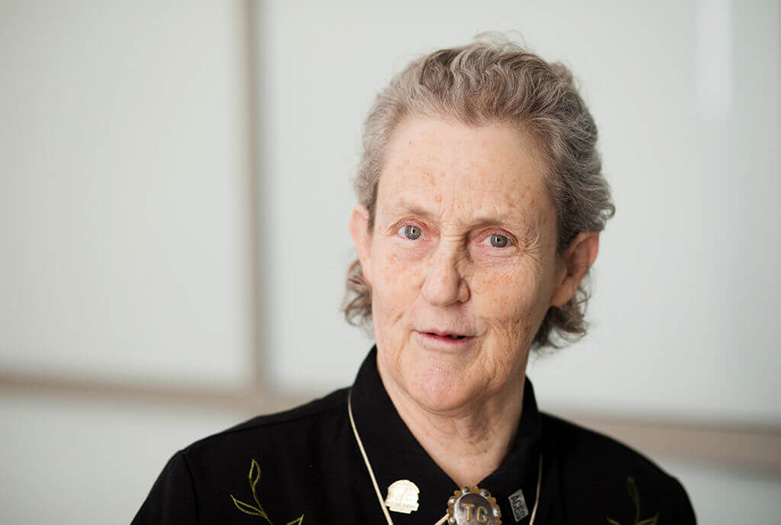
Thinking like the herd
Unable to speak until almost age four, no one expected Temple Grandin to do much in life, let alone become one of the world’s compelling voices in science and innovation. Yet, thanks to a determined mother, a tenacious spirit, and a summer away from home, the girl who thought in pictures did just that.
12 min read
Each month, our Journeys of Innovation series tells the stories of inventors or entrepreneurs whose groundbreaking innovations have made a positive difference in the world. Hear it in their own words or read the transcript below.
LINDA HOSLER: The world needs all types of minds. Unconventional thinkers bring unique perspectives to innovation, perceiving details that others often overlook. I’m Linda Hosler from the United States Patent and Trademark Office. I recently interviewed Temple Grandin, an inventor, professor, author, inspirational speaker, and a leading advocate for the humane treatment of livestock. Grandin is one of the world’s most well-known autistic individuals and proponents of neurodiversity. She also holds a U.S. patent for her farm animal handling system. Her journey as an inventor began as a young girl experimenting with flying objects and continued as a teenager at her aunt’s cattle ranch in Arizona. That experience was life-changing. It set her on a path to improve conditions in the livestock industry and to advocate for people with autism. Here is a bit of our conversation.
LINDA HOSLER: Could you talk a bit about the problems that you wanted to solve?
TEMPLE GRANDIN: I originally came from non-cattle background, and I got interested in the cattle industry because I was exposed to it as a teenager. This brings up a really important thing about careers. Students get interested in things they get exposed to. Or they might find out that they don't like something they're exposed to. That's equally important to learn.
LINDA HOSLER: And who exposed you at first?
TEMPLE GRANDIN: The beef cattle industry. I got exposed to it when I went to my aunt's ranch when I was 15 years old. I was originally an Easterner with no background in the cattle industry.
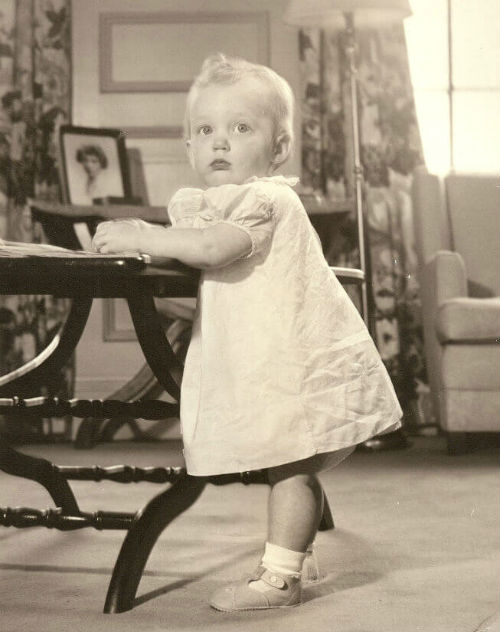
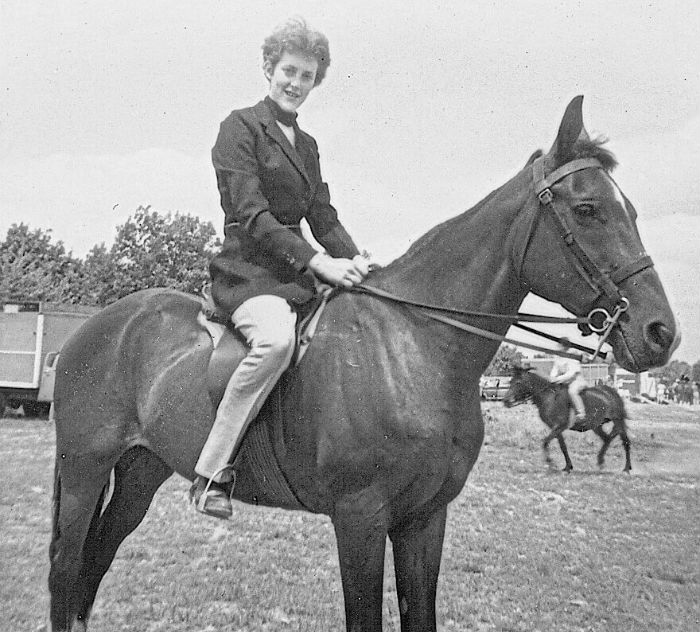
Left image: Temple Grandin as a child.
Right image: Temple as a teenager on her aunt’s cattle ranch. It was there that she invented her squeeze machine for calming cattle. Photos courtesy of Temple Grandin.
LINDA HOSLER: What were the problems that you saw in the cattle industry that you wanted to solve?
TEMPLE GRANDIN: When I first started in the cattle industry, I had no idea that I was a visual thinker, and the first thing I noticed—and I went around to every feed yard in Arizona to help them vaccinate the cattle—is that sometimes the animals would refuse to go up the chute and one place it might be orientation to the sun’s, staring right into the rising sun, or a vehicle parked next to a fence, or rope across the chute, a change in the flooring. And it was obvious to me to look at what the cattle were seeing. And at the time I thought everybody’s a visual thinker. I didn’t realize that my thinking was different, and I couldn’t understand why other people weren’t seeing this. And then I learned later on in life that some people are visual thinkers thinking photo realistic pictures like me or an object visualizer. Then you have the more mathematical type of person who is a pattern visualizer.
“I didn’t realize that my thinking was different, and I couldn’t understand why other people weren’t seeing this.”
Steve Jobs, an artist, designed the really easy-to-use interface on the iPhone, and the engineers had to make it work. That's the two different kinds of minds working together. And I found similar things in the meat industry. I would design cattle-handling facilities. I worked on a lot of different kinds of equipment, worked with many different steelworkers, and the visual thinkers invent all of the clever mechanical equipment, and the more mathematically inclined engineers will do things like boilers, refrigeration, stresses on pre-stressed concrete, [the] kind of stuff the visual thinkers don't understand, but you need the whole team working together. You need both kinds of minds.
I designed a piece of equipment called the double rail center track restrainer system, which I'm kicking myself I didn't get some patents on. I could have—highly patentable—but the problem was at the same time I was going to the University of Illinois working on my Ph.D. This was the mid-‘80s, and there was no patent attorney in Champagne-Urbana, or if there was I didn’t know how to find them, and I was too busy to get on a plane and fly someplace to see a patent attorney, so I put the whole thing into the public domain deliberately on purpose. But now I am kicking myself.
LINDA HOSLER: You mentioned that “hands on” being an important part of invention, can you talk about your own invention process?
TEMPLE GRANDIN: Well, as I design things, I see it in my mind. When I’m—the first thing I had to do to make this kind of process work is I had to go out in the field and see a lot of stuff so I know what different kinds of welded, and, you know, square tubing welded, you know metal plates welded on things. You know, what these things would look like, and then as I drew it, I found I could build it in my mind.
“I see it in my mind.”
LINDA HOSLER: Could you talk about a specific time where you struggled with an invention?
TEMPLE GRANDIN: I was in the, in the meat industry for, you know, out there designing things for about six or seven years and had my first failure, and I learned a big lesson from that, and it was an old fashioned meat-packing plant where the pigs had to walk up to the third floor, and some of these pigs were not able to walk up to the third floor. So they wanted me to build a conveyor system to take the pigs up to the third floor. And it was a gigantic failure, and it flipped the pigs over backwards. It was absolutely a mess. And I learned something from that, that was very, very fundamentally important. There's some things that engineering cannot fix. Prior to this time, I thought if I could build the right magical system, it would replace management. It would fix all the problems. I've learned you can only fix half the problems in engineering. The problem with the pigs was genetics, and it could have been fixed by changing the breeding of the pigs. See, that's an example of a, you know the root cause of a problem. Yes, and it was very upsetting to have this big failure, but it really drove home to me where engineering is appropriate to fix something and where management and other things would be a much more appropriate way to fix something.
LINDA HOSLER: Can you talk about who might have helped you along the way over the course of your career?
TEMPLE GRANDIN: I had some great helpers, starting with my mother. My art ability showed up around third grade. I was encouraged to do lots of different art, not just endless horse heads over and over and over again. Lots of art, and the visual thinkers like me, we tend to be the art kids, and then of course we grew up, making things. I mean kids played outside. Mathematical thinkers you'll start to see that maybe around second or third grade, kids really good at math, and what you need to do is move them ahead.
LINDA HOSLER: Who else helped you?
TEMPLE GRANDIN: My science teacher in high school—great science teacher in high school. He was a—he'd worked on spacesuits for NASA, and he gave me interesting projects to do. I was a poor student. I was not motivated to study, and I only got motivated to study when education became a pathway to a goal of becoming a scientist.
“I was a poor student…and I only got motivated to study when education became a pathway to a goal of becoming a scientist.”
LINDA HOSLER: I wanted to ask you a little bit about your advice for other innovators. What kind of advice would you give to other people who are interested in invention?
TEMPLE GRANDIN: Let's start with those kids. I have two favorite books when I was little: Black Beauty—the children's version of it—and a book about famous inventors. And it had people like Thomas Edison in there. There's Elias Howe on the sewing machine, and I profile some of those same... inventors in my book Calling All Minds. Let's get kids interested in making things. So all my childhood projects are in Calling All Minds. They're all inexpensive things like little paper kites, parachutes. I'm seeing kids today that haven't even cut out a paper snowflake.
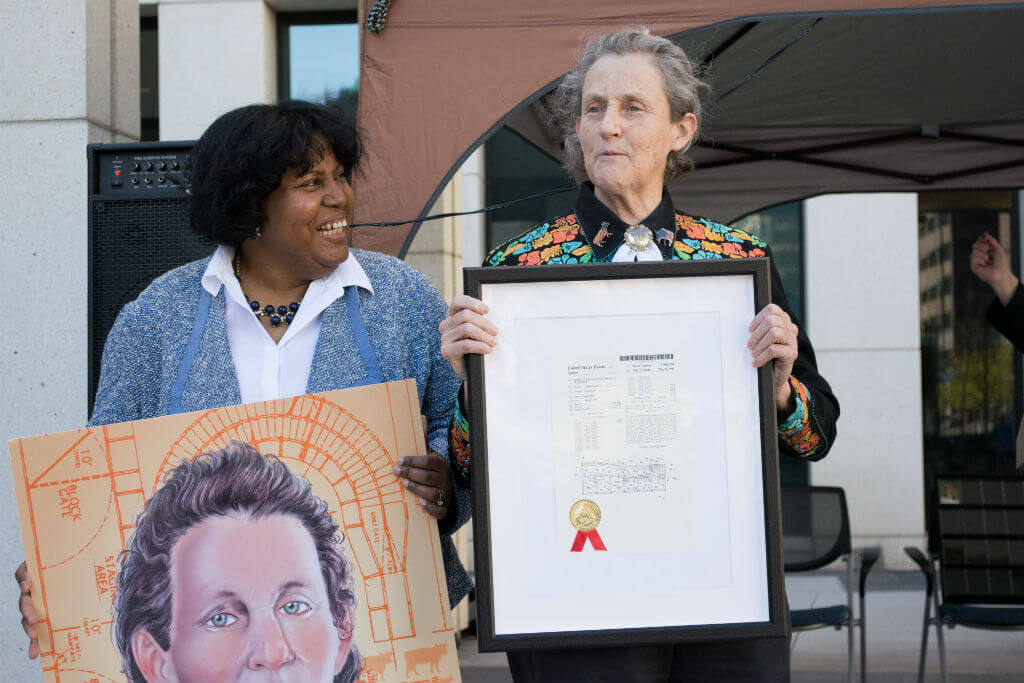
Grandin holding U.S. patent no. 5,906,540 for her invention of an animal-stunning system while the USPTO’s Director of Education and Outreach Joyce Ward (left) presents Grandin with an oversized copy of an inventor trading card depicting Grandin and her livestock-handling designs. USPTO inventor trading cards aim to inspire children with stories of diverse inventors such as Hedy Lamarr, Alfred Yi Cho, and George Washington Carver. Photo by Unsu Jung/USPTO.
TEMPLE GRANDIN: How do you just figure things out? That—that's the first step in getting them interested in inventing. I'm a big proponent of having maker spaces where kids can just figure things out. We got to get the hands-on stuff back in. And too many kids today are scared of making mistakes. I've seen smart kids destroy really good work because they had one tiny mistake in it. Well, you can't be perfect. You got to do quality work, but you just—there's no way you can be perfect.
LINDA HOSLER: What about for non-children inventors?
TEMPLE GRANDIN: First of all, you have to have some kind of problem that you have to solve. When I worked on my double rail center track restrainer system, the University of Connecticut had done a lot of work on it, and what the University of Connecticut did—and I learned from this because I saw their work when I first started—is they looked at the state of the art. They looked up every single patent, and back in those days in the ‘70s, this was difficult to see what's already out there. And I did a similar thing, going to every feed yard in Arizona to see what was already out there for cattle-handling facilities, because it’s really important not to reinvent the wheel. That’s kind of a stupid thing to do. So you want to, first of all, just see what the state of the art is, and then you can think up some new ways to fix things.
“It’s really important not to reinvent the wheel…You want to, first of all, just see what the state of the art is, and then you can think up some new ways to fix things.”
LINDA HOSLER: And then once that inventor has a problem, then what?
TEMPLE GRANDIN: I think Edison said it's 1% inspiration and 99% perspiration. I hope I'm quoting it right. He had a lot of failures when he was trying to figure out the filament for the electric light. You have to just keep trying something else. And then sometimes you'll just see a way to fix something. You can get an idea from something else that doesn't have anything to do with it.
LINDA HOSLER: Looking back at the impact of your inventions and your career, what are you most proud of?
TEMPLE GRANDIN: Probably the most important piece of equipment I developed was center track restrainer system—it's in all the big beef plants. In the literature it's called the double rail restrainer system, but the thing that probably changed the animal handling at the large meat plants the most was a very simple scoring system I developed, for assessing how well a meat plant does things. I didn't tell them how to build one. What I told them [was] what outcomes they have to have.
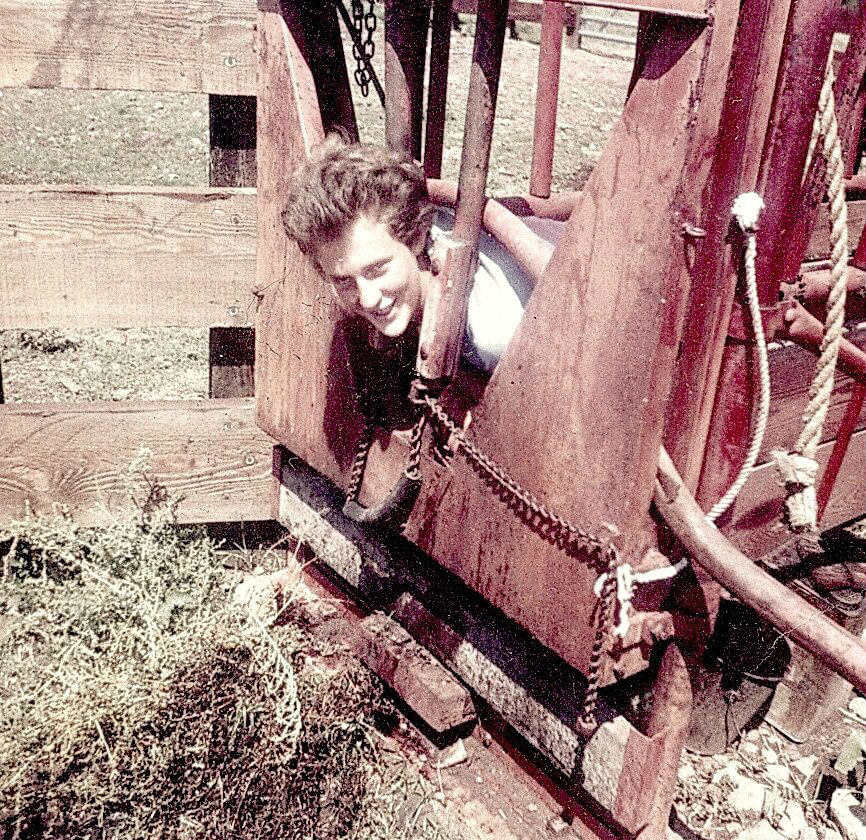
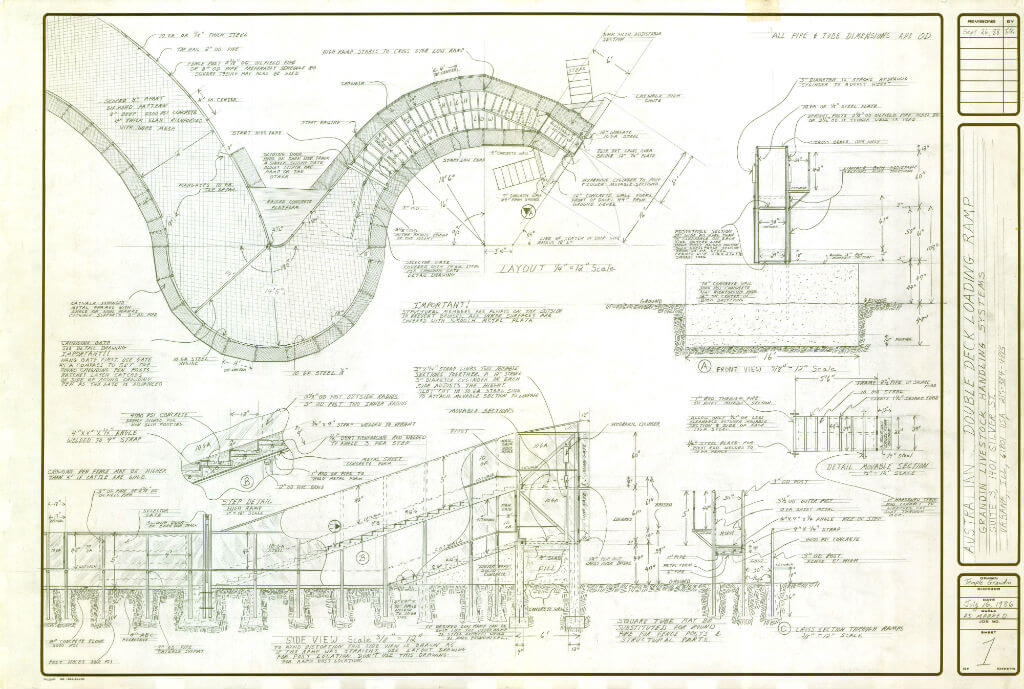
Grandin did not patent all of her inventions. At left, she poses in a cattle squeeze chute, which became the model for her “hug box” for calming people with autism, like herself. At right: the plans for her double deck loading ramp system, which helps keep livestock calm. Images courtesy of Temple Grandin.
TEMPLE GRANDIN: So they had five simple outcome measures that I measure. And then we had six acts of abuse that were automatic failures. And it was very clear, like traffic rules. And I do an exercise lots of times with different audiences to see how good they are at the critical control point approach. And I say, let's take traffic rules. If you could only have the police enforce three traffic rules, which three traffic rules would you have them enforce? And usually when I ask the audience to answer, I'll get speeding and I'll get the stopping violations, but sometimes they'll get off on turn signals and things that are definitely not critical control points, and on most audiences I have to cue them to get the drunk driving. That's number one.
I use that as an exercise of the critical control point approach and you look at stuff that police actually enforce. Those top three are the main things that they enforce, and you're probably getting 90% of your public safety.
I've been thinking about education a lot. I was a severely autistic kid, and I'm seeing some kids with autism and with other labels do extremely well in college and then not make it in the workplace because they never learned how to work. Kids have got to learn how to work.
I mean, Thomas Edison had a paper route at age 11. He was a telegraph operator at 14. I’ve read biographies on Thomas Edison. He would be autistic today. And so would Tesla, and so would Einstein. Einstein had no speech until age three. What would happen to these big innovators like Tesla, Einstein, and Edison in today’s educational system?
“[Thomas Edison] would be autistic today. And so would Tesla, and so would Einstein...What would happen to these big innovators…in today’s educational system?”
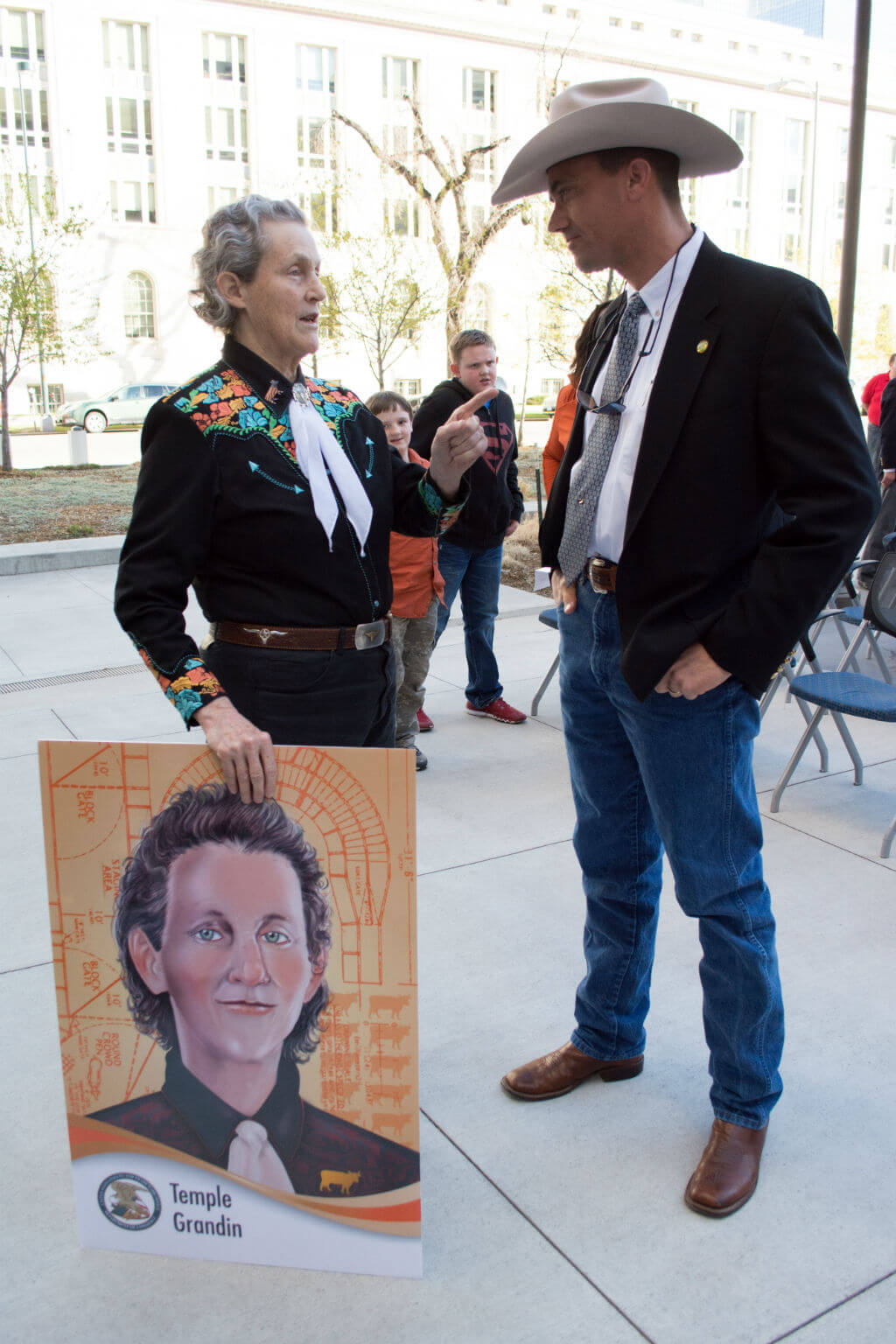
Grandin with her USPTO inventor trading card, presented to her in 2016 at the USPTO Rocky Mountain Regional Office in Denver, Colorado. Photo by Unsu Jung/USPTO.
LINDA HOSLER: I was wondering if there's anything else you wanted to tell us?
TEMPLE GRANDIN: I want to encourage kids to get out and make things, get out and do things, and with some of those kids out there that are different, a skilled trade would be a good place to go, and there's some people kind of stick their nose up at that.
There was skilled tradespeople out or there's some of them didn't even have a high school degree but they built really complicated stuff, and we have lost the know-how on building that stuff, and I think the reason for that is totally deemphasizing the skilled trades.
LINDA HOSLER: What a fascinating story. Many thanks to Temple Grandin for discussing her life and work, and for sharing her insights on educating people with different minds. From the USPTO, thank you for listening.
Credits
Produced by the USPTO Office of the Chief Communications Officer. For feedback or questions, please contact inventorstories@uspto.gov.
Interview by Linda Hosler. Cover photo on homepage copyright by Rosalie Winard. Portrait at top of this page by Jay Premack. All other photos credited in captions. Additional contributions by Rebecca Fritchman, Laura Larrimore, Eric Atkisson, and Alex Camarota.



